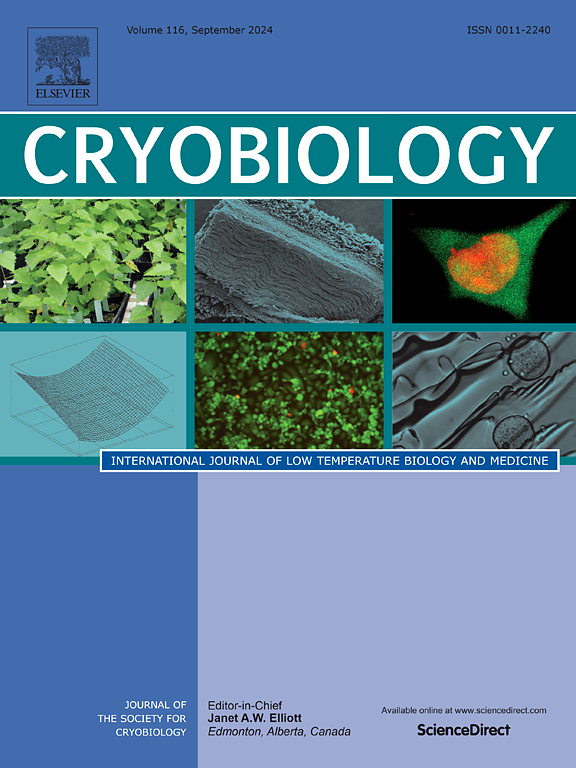Optimization of freezing and thawing protocols for human ovarian tissue cryopreservation through thermophysical characterisation of freezing medium by differential scanning calorimetry
IF 2.3
3区 生物学
Q2 BIOLOGY
引用次数: 0
Abstract
Fertility preservation should be offered to patients facing gonadotoxic therapy. The method for preserving prepubescent girls' fertility, which is also suitable for women, is ovarian tissue cryopreservation (OTC). Although 200 births have been reported worldwide with this approach, significant improvements are needed. The literature indeed reports numerous protocols for freezing and thawing ovarian tissue, with no clear rationale for selection criteria. This study aims to optimize human OTC protocols by characterizing the thermodynamic properties of freezing medium. The freezing medium associated with most live births after autograft (Leibovitz L-15 medium with 4 mg/mL human serum albumin (HSA), 1.5M DMSO, and 0.1M sucrose) was characterized using differential scanning calorimetry. We obtained −120.49 °C for glass transition temperature (Tg’), −20 °C for crystallization temperature when cooling at 2.5 °C/min (Tc) and −4.11 °C for melting temperature (Tm). With these parameters, we optimized a freezing protocol in a programmable freezer (Nano-Digitcool, Cryo Bio System) and a thawing protocol. The freezing curve was as follows: 5 min at 4 °C, 1 °C/min to −7 °C, seeding: 60 °C/min to −32 °C, and 10 °C/min to −15 °C, 0.3 °C/min to −40 °C, 10 °C/min to −140 °C. The thawing protocol consisted in a 3.5-min step in a cold chamber to reach slowly Tg', limiting thermal and mechanical shocks, and then a 2-min incubation at 37 °C to quickly reach Tm. Ovarian tissue frozen-thawed according to these protocols had a similar quality to that of fresh tissue and could resume folliculogenesis during organotypic culture. Our study will contribute to improve human OTC and optimize women fertility preservation.
通过差示扫描量热法对冷冻介质进行热物理表征,优化人卵巢组织冷冻和解冻方案
应向接受性腺毒素治疗的患者提供生育能力保存。保存青春期前女孩生育能力的方法,也适用于女性,是卵巢组织冷冻保存(OTC)。虽然全世界已有200例新生儿采用这种方法,但仍需进行重大改进。文献确实报道了许多冷冻和解冻卵巢组织的方案,没有明确的选择标准的基本原理。本研究旨在通过表征冷冻介质的热力学性质来优化人类OTC方案。采用差示扫描量热法对大多数自体移植后活产的冷冻培养基(含4mg /mL人血清白蛋白(HSA)、1.5M DMSO和0.1M蔗糖的Leibovitz L-15培养基)进行了表征。我们得到了- 120.49°C的玻璃化转变温度(Tg '), - 20°C的结晶温度在2.5°C/min冷却(Tc)和- 4.11°C的熔化温度(Tm)。利用这些参数,我们优化了可编程冷冻机(Nano-Digitcool, Cryo Bio System)中的冷冻方案和解冻方案。冷冻曲线为:4℃下5 min, 1℃/min ~ - 7℃,播种:60℃/min ~ - 32℃,10℃/min ~ - 15℃,0.3℃/min ~ - 40℃,10℃/min ~ - 140℃。解冻方案包括在冷室中3.5 min的步骤,以缓慢达到Tg',限制热冲击和机械冲击,然后在37°C下孵化2 min,以快速达到Tm。根据这些方案冷冻解冻的卵巢组织具有与新鲜组织相似的质量,并且可以在器官型培养期间恢复卵泡发生。我们的研究将有助于改善人类OTC和优化妇女生育能力的保存。
本文章由计算机程序翻译,如有差异,请以英文原文为准。
求助全文
约1分钟内获得全文
求助全文
来源期刊

Cryobiology
生物-生理学
CiteScore
5.40
自引率
7.40%
发文量
71
审稿时长
56 days
期刊介绍:
Cryobiology: International Journal of Low Temperature Biology and Medicine publishes research articles on all aspects of low temperature biology and medicine.
Research Areas include:
• Cryoprotective additives and their pharmacological actions
• Cryosurgery
• Freeze-drying
• Freezing
• Frost hardiness in plants
• Hibernation
• Hypothermia
• Medical applications of reduced temperature
• Perfusion of organs
• All pertinent methodologies
Cryobiology is the official journal of the Society for Cryobiology.
 求助内容:
求助内容: 应助结果提醒方式:
应助结果提醒方式:


